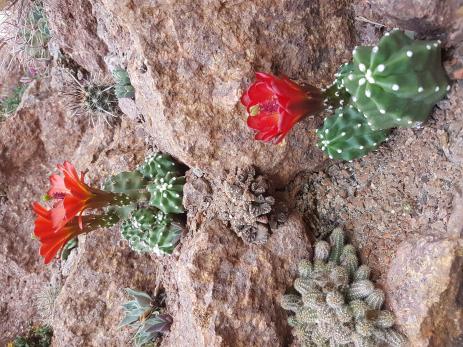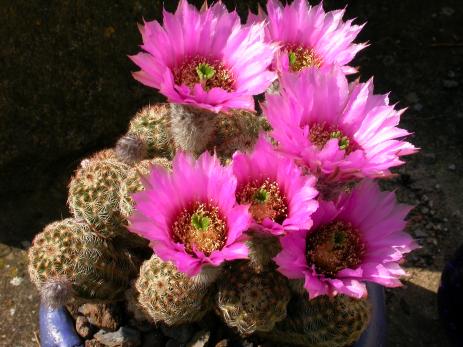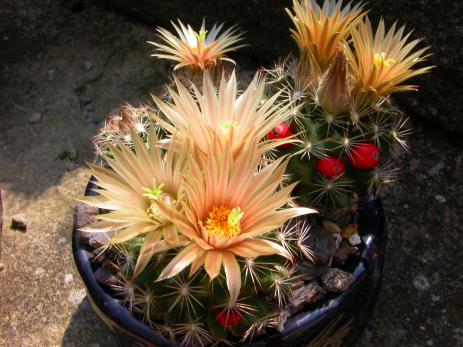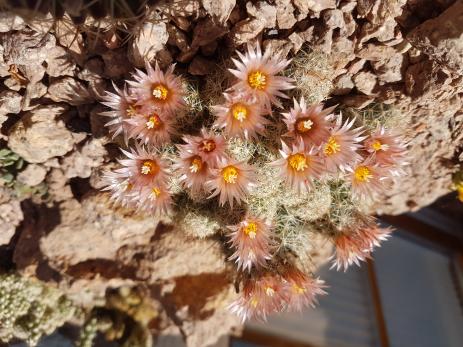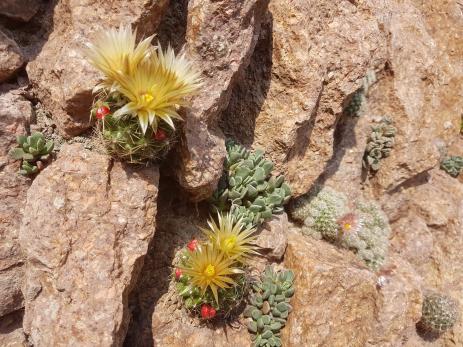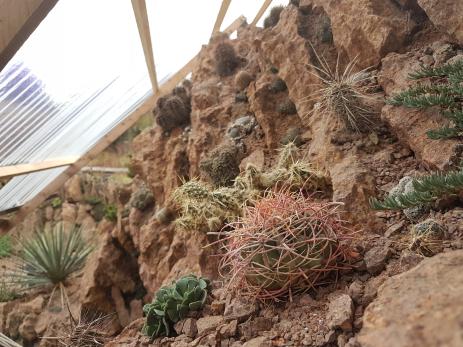PLANTING CACTI IN cold Germany? Most plant enthusiasts associate this with low-growing opuntias only. Being easy to propagate and resistant to the wet, cold, Central European winters, several species of this genus are widespread in German gardens, especially in the dry areas of Thuringia and Saxony-Anhalt. On wall tops and in troughs, without any artificial watering, they withstand severest weather conditions.
Opuntia phaeacantha, O. polyacantha, O. humilis, and O. fragilis are the most commonly planted species. They can withstand harsh winters in USDA zones 7, 6, or even 5. Their glochids are notorious: micro-spines which form dense clusters in the areoles. The slightest contact usually results in bunches of these miniature-barbed spines in your skin. They can only be extracted with tweezers and an extra measure of patience.
In late spring, opuntias enchant with large, bright flowers, but mature clumps often die off after a few years. To guarantee healthy plants, you should periodically take cuttings for re-propagation. In a rainy climate, the fruits that remain after blooming should be removed because water can collect at their base long enough to trigger rot.
The closely related genus Cylindropuntia comprises cacti with cylindrical stems. The tallest frost-tolerant species is C. imbricata, which reaches more than two meters (6.6 ft) in height, even in German Zone 5 regions. Opuntia and Cylindropuntia are the most famous members of the cacti subfamily Opuntioideae. The steeper a rock garden, the less suitable it is for these genera, as pads could fall down and become an injury risk, though using them in dry stone walls may be an option to discourage undesired guests.
However, the Cactaceae family comprises also a considerable diversity of frost-resistant members outside the Opuntioideae. These are mostly ball- or egg-shaped species, and though spiny, they are free from troublesome glochids and so they are less hazardous if planted in steep crevice gardens.
North American Species
Many dry areas in western North America are counted as hardiness zone 7a or below. This means average minimum temperatures of 0 °F (-17.8 °C) or even less occur in their natural habitats. Cacti from such regions can be used outdoors in many areas of Central Europe, at least if protected from rain during winter. The genera Echinocereus and Escobaria in particular include suitable species.
Echinocereus species have oval or elongated bodies, which often develop into little groups through basal sprouting. They bloom in early summer, often in red or pink, sometimes in yellow or green. Echinocereus reichenbachii is densely covered in brownish or white spines which give the plants an attractive appearance even without flowers. Echinocereus reichenbachii subsp. baileyi has protruding thorns while subsp. caespitosus usually has only radial spines, flatly attached to the plant body.
Echinocereus triglochidiatus has an immense variety of shapes and spinations, but consistently produces cup-shaped, bright red flowers which are responsible for the species’ common name of claret cup cactus. Its natural distribution stretches about between eastern California, Nevada, Colorado, and Arizona. Often very differently spined specimens grow just beside each other. Echinocereus coccineus was described as its own species by Engelmann, but W.T. Marshall and T.M Bock (authors of Cactaceae: With Illustrated Keys of All Tribes, Sub-Tribes and Genera) categorized it as a variety of E. triglochidiatus. The light red-flowered E. triglochidiatus var. octacanthus is often listed as E. roemeri. Very popular claret cup types are the minimally spined var. gonacanthus, var. monacanthus with mostly only one thorn per areole, and the completely thornless form var. mojavensis forma inermis. Seeds of forma inermis produce seedlings both with and without thorns.
Rather small, but also very frost resistant, is Echinocereus viridiflorus. Its greenish-yellow flowers appear in a ring around the apical zone of the plant. The tiniest Echinocereus is E. viridiflorus var. davisii, which is sometimes considered its own species, E. davisii. Depending on their particular provenance, forms of E. engelmannii, E. stramineus, E. fendleri, E. dasyacanthus, E. relictus, and E. adustus can be quite winter hardy.
Escobaria species are globe-shaped or elongated, with separated podarias (tubercles), not grown together in ribs but sticking out from the plant body as warts. The distribution of Escobaria vivipara reaches northward to southern Canada. Some types are even referred to USDA hardiness zone 4. Escobaria missouriensis (syn. Neobesseya missouriensis) forms shallow spherical cushions. They often show flowers and fruits simultaneously.
Escobaria sneedii develops thriving, multi-branched cushions with a dense, white spination. Usually, it withstands frosty German winters even without rain protection. Its little pink flowers appear in late summer. The more compact subspecies leei is a slow grower, which seems to be sensitive to limestone substrates.
Escobaria orcuttii forms thick, cylindrical stems up to 15 cm (6 inches) or taller. They are covered with dense white spines. In my garden, it also had no problems with frosty winters even without rain protection.
A few representatives of Mammillaria, Coryphantha, Ferocactus, and Epithelantha are worth trying in protected outdoor plantings, if they are descendants from adequately winter cold provenances. Rarer, and usually also more difficult in cultivation, are species from the genera Pediocactus, Sclerocactus, and Navajoa. Though mostly resistant to deep frost, they are very prone to rotting if kept only a bit too moist. They’re easier to grow if grafted as young seedlings on hardy Echinocereus, Cylindropuntia imbricata, or C. kleiniae.
South American Species
Argentina, from Mendoza Province southward, is home to several cacti which can withstand frosty German winters outdoors, at least under a rain protection cover. Austrocactus species may be of great interest to plant enthusiasts; unfortunately, they are not often available in nurseries. A few Gymnocalycium species, as well as the two Maihuenia species (M. patagonica and M. poeppigii), which form their own subfamily, and the Opuntioideae members Tephrocactus and Pterocactus occur here and are quite cold hardy.
Furthermore, in the high altitudes of the central and northern Argentinian Andes, more cacti grow which could be hardy, at least in milder regions of Central Europe. In my own garden, Lobivia silvestrii (Syn. Chamaecereus silvestrii, Echinopsis chamaecereus) thrived for four years. The 2020-2021 winter with minus 22°C (-7.6°F) temperatures destroyed some in very exposed locations, but plants in protected crevices with completely dry substrate survived. This species occurs at 2,500 to 3,500 meters (8,200 – 11,500 ft) above sea level in Salta Province in northern Argentina.
Hardy Cacti in Troughs and Pots
The great advantage of planting cacti and other succulents sensitive to winter rain in troughs or pots is that they can be transferred under a roof during the cold season. Plants which are not fully hardy can be covered with a fleece or conifer twigs, but no moisture must occur under such materials. Or you can store them in a glass house, garage or any cool and not too dark room. Echinocereus triglochidiatus and E. reichenbachii withstood minus 27°C (-16.6 F) under rain protection in little clay bowls.
Succulents in Crevices
In 2014, I framed my veranda with a steep crevice garden built from quarry rough slabs of rhyolite, a reddish granite variant, which is mined nearby Halle in Saxony-Anhalt. The 10-meter (33 ft) long veranda’s floor rises about one meter (3.3 ft) above the garden plane, but this difference in level increases up to 2.5 meters (8.2 ft) at the eastern part because of a depression which leads to a cellar entrance below. The stones were set upright with a slight angle eastward so that plants placed directly behind receive some rain protection.
I used pure silicate sand (0.063-2 mm) as backfill substrate. Directly between the stone slabs, I added rhyolite gravel (0-8 mm) to let the neighboring stone flags visually melt together and appear as a unified rock massif.
A nearly vertical, partly protruding stone set above the eastern cellar entrance adds an extra dramatic effect. Here, the stones are backfilled with concrete for safety reasons. Between the upright rhyolite slabs there are 10-20 cm (3.9-7.9 in) deep gaps for cacti and other hardy succulents. The substrate for these planting niches consists of six parts sand, two parts rhyolite grit, three parts coarse peat, and one part trass cement powder. A minor addition of brick dust ensures the desired reddish hue to match the rhyolite rock. Trass is a special term for volcanic tufa. As a component of cement, it guarantees that no lime efflorescences will disturb the visual quality. This substrate must be moist when the plants are set to ensure stable positioning. It can be tightly pressed around the roots because its coarse structure will ensure proper aeration after the cement’s hardening.
As director of the campus gardens of Anhalt University, Bernburg, I tested this planting method successfully in a trial at a dry stone wall with several rock garden plants. After a few years, the fixing effect of the cement decreases, but then the roots take over the stabilization.
In the steep wall, diverse Echinocereus triglochidiatus varieties thrive. They were inserted as over ten-year-old multi-branched plants and bloom well every year. Smaller specimen of Echinocereus reichenbachii provide attractive contrasts with their light-colored spination.
Well-proven companions are Sempervivum arachnoideum, S. calcareum, Orostachys spinosus, and Duvalia calcicola. They all survived the severe temperature of minus 22°C (-7.6°F) in the winter of 2020-2021. So did the Aizoaceae members Stomatium mustellinum, Delosperma sutherlandii and D. basuticum (syn. Malotigena frantiskae-niederlovae), while Aloinopsis spathulata, Bergeranthus jamesii, Hereroa calycina, and Titanopsis calcarea failed completely. In the years before, those last four species had withstood minus 15°C (5°F), so this seems to be about their tolerable minimum. Maybe provenances from higher altitudes are hardier.
The cellar entrance faces a small patio, framed south and eastward by a steep rhyolite crevice garden to bridge the garden and cellar levels. The north side of the patio is the basement wall of the house. Steep stairs run along the house wall and separate the crevice garden from the house façade, which is partly clad with rhyolite flags analogous to the stone setting above the cellar entrance. Here, smaller cacti such as Gymnocalycium gibbosum, Echinocereus viridiflorus, Escobaria dasyacantha, E. missouriensis and E. sneedii grow well.
Escobaria sneedii var. leei was the only species that did not accept the substrate-concrete mixture. Meanwhile, I changed to a substrate mix of sand, rhyolite gravel, and peat moss, which had a significantly better appearance. Peat moss seems to be a proper alternative to cement because it stabilizes even fine-grained substrates well.
Experiences on Wall Crown and in the Gravel Bed
The wall crown above the cellar entrance overtops the veranda floor. It is backed from a mortared wall and forms a balustrade along the veranda’s east margin. The wall crown is covered with a 10 to 15 cm (3.9 - 5.9 in) layer of rhyolite grit and fine-grained expanded slate. On this very exposed site, several Echinocereus and Escobaria plants grow. The bed stretches along the house façade, protected by the protruding roof. Here, more sensitive species such as Pediocactus simpsonii, Mammillaria heyderi, Gymnocalycium andreae, G. bruchii, Epithelantha micromeris, Austrocactus bertinii, Ferocactus cylindraceus and some grafted Sclerocactus parviflorus were planted. They all survived even the frosty winter of 2020/21. However, Epithelantha and Ferocactus cylindraceus appeared stressed enough to transfer them into the glasshouse.
At the east façade of the house a steep gravel garden, stabilized again by rhyolite stone slabs, was built. An east-facing slope is quite suitable for many succulents, especially since they often grow below taller shrubs or between rock boulders in nature. The substrate was initially pure rhyolite grit (1-8mm, 0.039-0.315 in). Though hardy agaves, Yucca nana, a few opuntias, and diverse Escobaria and Echinocereus species established there, I would recommend using a substrate with finer particles. Sand, or even a bit of clay or loam, should be mixed into the grit. This would also increase the thermal conduction from below and keep the plants’ base better protected from frost damages in winter.
It is very important, especially for opuntias, agaves, and Echinocereus triglochidiatus, to feed them regularly with a normal flower fertilizer (N:P:K = 12:6:8 or similar) from spring till the end of June on such a permeable substrate with a low nutrient storing capacity.
Winter Protection
From November to March, the planting is covered with transparent corrugated plastic sheets to protect the plants from winter rain. After removing the temporary construction in spring, the first intensive watering plus dilute liquid fertilizer is given as soon as the daily temperature exceeds about 15°C (59°F). After a few days the wrinkly desiccated bodies swell and look lush again. In May and June, most Echinocereus species and pediocacti bloom, followed by escobarias and gymnocalycias. Escobaria vivipara often produces bright pink flowers till late summer, followed by tasty fruits.



